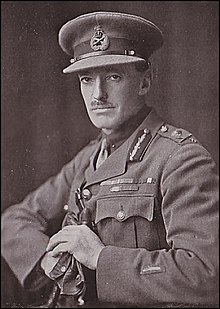Gerald Boyd (British Army officer)
Sir Gerald Boyd | |
|---|---|
 | |
| Born | 19 November 1877 London, England |
| Died | 12 April 1930 (aged 52) London, England |
| Buried | Putney Vale Cemetery, London |
| Allegiance | United Kingdom |
| Service | British Army |
| Years of service | 1895–1930 |
| Rank | Major-General |
| Unit | Devonshire Regiment East Yorkshire Regiment |
| Commands | Staff College, Quetta Dublin District 46th (North Midland) Division 170th (2/1st North Lancashire) Brigade |
| Battles / wars | Second Boer War First World War |
| Awards | Knight Commander of the Order of the Bath Companion of the Order of St Michael and St George Distinguished Service Order Distinguished Conduct Medal Mentioned in Despatches |
Major-General Sir Gerald Farrell Boyd, KCB, CMG, DSO, DCM (19 November 1877 – 12 April 1930) was a senior British Army officer who served as Military Secretary from 1927 to 1930.
Military career
Educated at St Paul's School,[1] Boyd enlisted into the Devonshire Regiment in 1895. He fought in the Second Boer War of 1899–1902, and took part in the Relief of Ladysmith, including the actions at Colenso; and in the operations in Orange River Colony, including the action at Wittebergen. During the war, he was commissioned into the 2nd Battalion, East Yorkshire Regiment in May 1900,[2] and promoted to lieutenant in that regiment on 26 April 1902.[3] He was mentioned in despatches three times (including 25 April 1902),[4] received the Queen's South Africa Medal, and was appointed a Companion of the Distinguished Service Order (DSO) for his war service.[5] The battalion stayed in South Africa throughout the war, and he returned home on the SS Orotava in December 1902, when they were stationed at Aldershot.[6] He went on to be Brigade Major for 11th Infantry Brigade in September 1912.[2][7]
Boyd served in the First World War with the 11th Infantry Brigade as part of the British Expeditionary Force.[2] Promoted in March 1915 to major, when he transferred to the Royal Irish Regiment,[8] he became a General Staff Officer with 1st Division and with the 6th Division before becoming a Brigadier-General on the General Staff of 5th Army Corps in France in 1916.[2] He was promoted to brevet colonel in January 1917.[9] He was made commander of the 170th Infantry Brigade in France in July 1918 and, after being promoted to the temporary rank of major general in September,[10] was made general officer commanding (GOC) of the 46th (North Midland) Division.[2] He led the 46th Division when it successfully stormed the Hindenburg Line at Bellenglise during the Battle of St Quentin Canal.[1]
After the war Boyd was made a Brigadier General on the General Staff at General Headquarters of British Army on the Rhine and then General Officer Commanding Dublin District in Ireland in 1920.[2] He was appointed commandant of the Staff College, Quetta, in 1923 and Military Secretary in 1927.[2] He died of cerebral spinal fever in 1930.[1]
Family
In 1913 Boyd married Grace Sophia Burdett and they went on to have two sons.[1]
References
- ^ a b c d "Boyd, Sir Gerald Farrell". Oxford Dictionary of National Biography. Retrieved 13 June 2020.
- ^ a b c d e f g "Boyd, Sir Gerald Farrell". Liddell Hart Centre for Military Archives. Archived from the original on 25 September 2012. Retrieved 13 June 2020.
- ^ "No. 27474". The London Gazette. 16 September 1902. p. 5962.
- ^ "No. 27428". The London Gazette. 25 April 1902. p. 2766.
- ^ "No. 27490". The London Gazette. 31 October 1902. p. 6901.
- ^ "The Army in South Africa – Troops returning home". The Times. No. 36957. London. 22 December 1902. p. 10.
- ^ "No. 28649". The London Gazette. 1 October 1912. p. 7193.
- ^ "No. 29146". The London Gazette (Supplement). 27 April 1915. p. 4147.
- ^ "No. 29886". The London Gazette (Supplement). 29 December 1916. p. 15.
- ^ "No. 30949". The London Gazette (Supplement). 11 October 1918. p. 12042.
Further reading
- Priestley, R. E. (1919). Breaking the Hindenburg Line. London: T. Fisher Unwin, Ltd.
